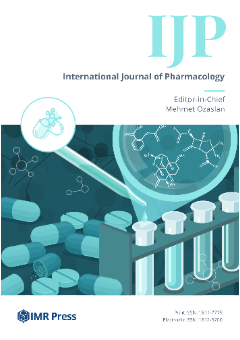International Journal of Pharmacology (IJP) is published by IMR Press from Volume 21 Issue 4 (2025). Previous articles were published by another publisher under the CC-BY licence, and they are hosted by IMR Press on imrpress.com as a courtesy and upon agreement.
Rutaecarpine Prevents High Glucose-induced Cx37 Gap Junction Dysfunction in Human Umbilical Vein Endothelial Cells
Background and Objective: Gap junction (GJ) dysfunction induced by altered expression of connexin are associated with the pathogenesis of diabetes cardiovascular complications. The authors explored the effects of rutaecarpine, an active ingredient of Chinese herbal medicine Evodia, on GJ dysfunction induced by high glucose. Materials and Methods: Human umbilical vein endothelial cells (HUVECs) were treated with different concentration of high glucose (5.5, 22, 33 and 44 mM) for 48 h and mannitol group (5.5 mM glucose plus 27.5 mM mannitol) as osmotic control. To test the effects of rutaecarpine, cells were pretreated with 0.1, 0.3 and 1 μM rutaecarpine for 10 min before high glucose (33 mM) treatment. The protein level of connexins were detected by western blot. The GJ function of endothelial cells was measured by scrape-loading dye transfer experiments. Endothelial cell function was evaluated by cell viability (MTT), NO production and ROS level (DCFH-DA). Results: Western blot indicated that high glucose 33 or 44 mM reduced the level of Cx37, but had no impact on expression of Cx40 and Cx43. Scrape-loading dye transfer showed that high glucose impaired PI Cx37-permeant dye diffusion between HUVECs. Pretreatment with rutaecarpine (0.1, 0.3 and 1 μM) recovered the level of Cx37, thereby improving PI-mediated GJ communication and prevented endothelial dysfunction, as indicated by increased cell viability and NO production, as well as decreased ROS level. Additionally, flow cytometry showed that rutaecarpine induced the influx of Ca2+. These effects of rutaecarpine were attenuated by capsazepine, an antagonist of transient receptor potential vanilloid subtype 1 (TRPV1). Conclusion: These data indicate that rutaecarpine prevented high glucose-induced GJ dysfunction by recovering Cx37 level via activation of TRPV1.

